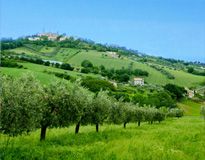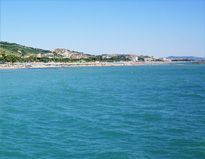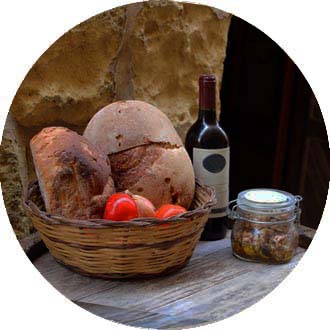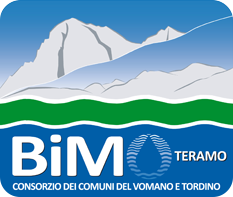Notaresco territory is a town of almost 7,000 inhabitants lying on a hill 260 m above sea level from which dominates the valley below. It is 25 kilometers away from the provincial capital Teramo and is just minutes from the Adriatic coast and less than an hour from the slopes of the Gran Sasso.
It is made up of several hamlets, including some, such as the Guardia Vomano and the Pianura Vomano, populated and dynamic. The former can also boast an ancient foundation and in the second half of the twentieth century progressively expanded into the Vomano valley, joining another fraction, Pianura Vomano precisely, forming almost a single settlement full of artisan, industrial, productive activities. and commercial.
The origins of Notaresco are not well defined, although certainly ancient seen the discovery of tombs of the VI-VII century in the district of Santa Lucia. Today's inhabited center was established and consolidated in the Middle Ages around the "Castle" of Lothario, nephew of Charlemagne, so much so that in the Catalog of the Barons (1150-1168) it is called Lotaresco. From the early 14th century it was a fief of the Acquaviva family who nevertheless shared its possession with Trasmondo III di Castelvecchio.
Shortly thereafter, exactly in 1324, a name similar to the current one appeared, that is, Nutrisco. During the Risorgimento epic, Notaresco was noted for the active participation of many of its citizens in the independentist and unitary events. Even in 1848 in Notaresco began the publication of one of the oldest and most famous Italian newspapers,
The viewer of the Italian destinies, on the impulse of the priest of liberal sensibilities Antonio Sabatini. Notaresco also succeeded in expressing a high-level political ruling class attentive to the needs of citizens and the territory, starting with Giuseppe De Vincenzi (1814-1903), agronomist expert (president of the Italian Farmers' Association from June 1895 to February 1896 ), author of philosophical writings, as well as deputy in various legislatures and Minister of Public Works of the Kingdom of Italy in the governments led by Ricasoli and Lanza.
The history of Notaresco, however, is also linked to sad and dramatic events such as that of the internment camp that began functioning from 13 July 1940 in a building belonging to the Marquises De Vincenzi-Mazzarosa (today via Borgo, 14) and in home of Eligio Liberi (currently known as "Casa Carusi", in via Giardino, 14).
The first building could accommodate up to 90 interns, the second 41, but until July '43 was constantly overcrowded. The internees were almost all foreign Jews or stateless persons and from March-April '42 also partisans from Dalmatia and Istria. In the two-year period 1943-44 the prisoners were transferred to other camps, until the final concentration camp closed in June 1944.
The gastronomic tradition of Notaresco is fully integrated into the traditional Teramo cuisine. One of the typical dishes are the so-called mazzarelle, that is rolls of lamb entrails wrapped on lettuce leaves. The ingredients for six people are the following: a lamb coratella (heart, liver and guts), a glass and a half of wine, a bunch of marjoram, a bunch of garlic with leaves, a bunch of parsley, some lettuce leaves, onions fresh and enough pepper (or chili pepper), flour, vinegar and salt.
The preparation is carried out according to the following procedure: the first step is the opening of the guts in the sense of their length. It is therefore necessary to wash and rinse them carefully, better if they are floured and squeezed for at least three times. When the guts become light and will be well cleaned, proceed with a final rinse with water and vinegar. At this point we move on to the core, making strips of the thickness and length of a finger.
The must then rinse and drain after salting it with the guts. Prepare separately the bunch of fresh and parsley and the lettuce leaves and fresh onions. Take a lettuce leaf and place 3-4 strips of coratella on it, adding a little onion, parsley and garlic. It binds the bunch with the guts and as the mazzarelle are packaged you have to put them to drain.
At this point put the mazzarelle to cook only in oil and, when they start to fry (and oil and water will be absorbed), add half a glass of water and wine. Once absorbed, pour again the same amount of water and wine. Finally repeat the operation a third and last time. Finally, add a pinch of marjoram leaves and a pinch of pepper. Serve hot.
Market: Friday
Twinning: With the Polish city of Płońsk (since 2008).
Website: http://www.comune.notaresco.te.it/
- Collemarino
- Frazione Cordesco
- Frazione Grasciano
- Frazione Vallevignale
- Guardia Vomano
- Località Caporipe
- Notaresco (City)
- Pianura Vomano
By Car
- From North From Ancona, via A14, exit at Teramo / Giulianova / Mosciano Sant'Angelo, take the SS80 towards Teramo, continue along the SP22 towards Notaresco.
- From the South Motorway A14 exit Roseto degli Abruzzi continue along the SS 150 in the direction of Montorio al Vomano, continue following signs for Notaresco (SP 553).
Train
Notaresco has its own railway station served by the regional routes of Trenitalia and Sangritana. Change at the FF.SS. station is required. of Giulianova from which that of Notaresco is about 15 minutes by train.
 en
en 


















